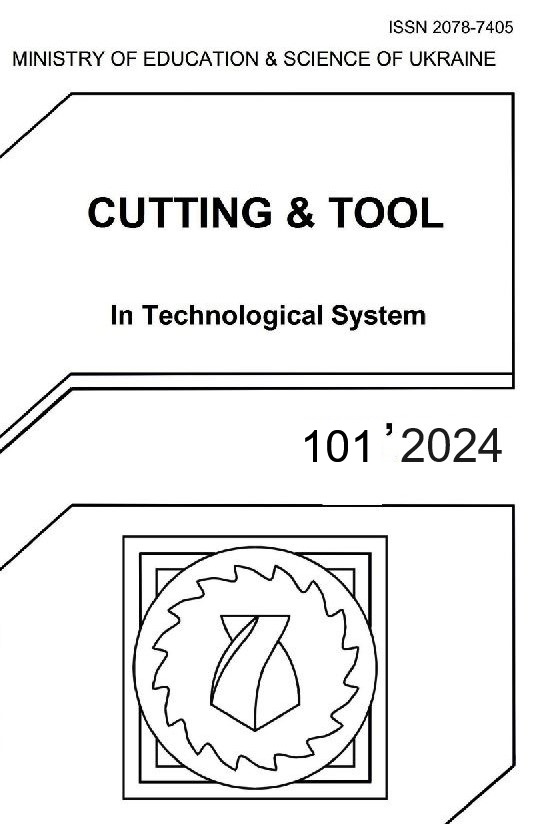THE ESSENCE OF THE PROCESS OF VIBRATIONAL FINISHING AND CLEANING, ITS TECHNOLOGICAL CAPABILITIES AND WAYS TO INCREASE EFFICIENCY
DOI:
https://doi.org/10.20998/2078-7405.2024.101.11Keywords:
vibration finishing and cleaning, process classification, workpieces, classification of shaping defects, combination of technical solutions, area of application of the process, process varietiesAbstract
The main provisions of the classification of the vibration processing process depending on the characteristics and composition of the processing medium are given. It is established that vibration processing is a mechanochemical removal of metal particles and its oxides, and plastic deformation of the microroughness of the surface of the part. It was found that vibration processing is related to mechanical dynamic processes, when using chemically active solutions it is related to mechanochemical processes, according to technological purpose to dimensionless processes, according to the type of tool – to processing with free abrasives. It was determined that vibration processing is characterized by the dynamic mechanochemical effect of abrasive medium granules on the treated surface and the acoustic effect of shock waves. It has been established that the features of mechanical and physicochemical phenomena of vibration processing differ in the physical properties of the granules of the medium, the characteristics of the material of the processed parts, the dynamic nature of the process, the composition and properties of the chemically active solution. A classification of defects in the formation of parts, controlled parameters and vibration processing operations is given. The technological capabilities of the processing are presented, these are micro-cutting and surface plastic deformation, the effect of variable accelerations and continuous application of micro-impacts to the surface being processed, which ensures the dynamic nature of the process and creates conditions for strengthening and stabilizing processing. The design of the vibration machines allows the use of various compositions of solid, liquid and mixed compositions of working media. To increase the efficiency of the process, a variable scheme for combining technical solutions of new varieties of the vibration processing process is proposed. It has been established that by combining various combinations of technological and design parameters it is possible to expand the scope of application of the vibration finishing and cleaning process based on the creation and implementation of its varieties.
References
Kang YS, Hashimoto F, Johnson SP, Rhodes JP (2017) Discrete element modeling of 3D media motion in vibratory finishing process. CIRP Ann 66:313–316. https://doi.org/10.1016/j.cirp.2017.04.092
Tools for machining parts with free abrasives (in Ukrainian): monografіja / M.O. Kalmykov, T.O. Shumakova, V.B. Strutins'kij, L.M. Lubens'ka. Kyiv – Luhans'k: «Noulіdzh», 2010. 214 р.
Uhlmann, E., Dethlefs, A. & Eulitz, A. Investigation into a geometry-based model for surface roughness prediction in vibratory finishing processes. Int. J. Adv. Manuf. Technol. 75, рр. 815–823 (2014). https://doi.org/10.1007/s00170-014-6194-8
Mitsyk А.V., Fedorovich V.A., Ostroverkh Y.V. Purpose and technological properties of granular media for vibration finishing and grinding processing. Cutting & Tools in Technological System. Kharkiv, NTU «KhPІ». 2023. № 99. рр. 85 – 93. https://doi:10.20998/2078-7405.2023.99.10
Kundrák, J., Morgan, M., Mitsyk, А., Fedorovich, V. The effect of the shock wave of the oscillating working medium in a vibrating machine’s reservoir during a multi-energy finishing-grinding vibration processing. Int. J. Adv. Manuf. Technol., 106, рр. 4339–4353 (2020). https://doi.org/10.1007/s00170-019-04844-2
Kundrák, J.; Mitsyk, A.V.; Fedorovich, V.A.; Morgan, M.; Markopoulos, A.P. The Use of the Kinetic Theory of Gases to Simulate the Physical Situations on the Surface of Autonomously Moving Parts During Multi-Energy Vibration Processing. Materials 2019, 12, 3054. https://doi.org/10.3390/ma12193054
Downloads
Published
Issue
Section
License
Copyright Notice
Authors who publish with this Collection agree to the following terms:
1. Authors retain copyright and grant the Collection right of first publication with the work simultaneously licensed under a Creative Commons Attribution License that allows others to share the work with an acknowledgement of the work's authorship and initial publication in this Collection.
2. Authors are able to enter into separate, additional contractual arrangements for the non-exclusive distribution of the Collection's published version of the work (e.g., post it to an institutional repository or publish it in a book), with an acknowledgement of its initial publication in this Collection.
3. Authors are permitted and encouraged to post their work online (e.g., in institutional repositories or on their website) prior to and during the submission process, as it can lead to productive exchanges, as well as earlier and greater citation of published work.

